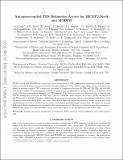| dc.contributor.author | Orlando, Abigail Claire | |
| dc.contributor.author | Aikin, R. W. | |
| dc.contributor.author | Amiri, M. | |
| dc.contributor.author | Bock, J. J. | |
| dc.contributor.author | Bonetti, J. A. | |
| dc.contributor.author | Brevik, J. A. | |
| dc.contributor.author | Burger, B. | |
| dc.contributor.author | Chattopadthyay, G. | |
| dc.contributor.author | Day, P. K. | |
| dc.contributor.author | Filippini, J. P. | |
| dc.contributor.author | Golwala, S. R. | |
| dc.contributor.author | Halpern, M. | |
| dc.contributor.author | Hasselfield, M. | |
| dc.contributor.author | Hilton, G. C. | |
| dc.contributor.author | Irwin, K. D. | |
| dc.contributor.author | Kenyon, M. | |
| dc.contributor.author | Kovac, John M | |
| dc.contributor.author | Kuo, C. L. | |
| dc.contributor.author | Lange, A. E. | |
| dc.contributor.author | LeDuc, H. G. | |
| dc.contributor.author | Llombart, N. | |
| dc.contributor.author | Nguyen, H. T. | |
| dc.contributor.author | Ogburn, R. W. | |
| dc.contributor.author | Reintsema, C. D. | |
| dc.contributor.author | Runyan, M. C. | |
| dc.contributor.author | Staniszewski, Z. | |
| dc.contributor.author | Sudiwala, R. | |
| dc.contributor.author | Teply, G. | |
| dc.contributor.author | Trangsrud, A. R. | |
| dc.contributor.author | Turner, A. D. | |
| dc.contributor.author | Wilson, P. | |
| dc.date.accessioned | 2017-07-14T20:05:09Z | |
| dc.date.issued | 2010 | |
| dc.identifier | Quick submit: 2017-02-12T20:59:19-0500 | |
| dc.identifier.citation | Orlando, A., R. W. Aikin, M. Amiri, J. J. Bock, J. A. Bonetti, J. A. Brevik, B. Burger et al. 2010. "Antenna-coupled TES bolometer arrays for BICEP2/Keck and SPIDER." In Proceedings of SPIE International Society for Optics and Photonics (SPIE) Astronomical Telescopes+ Instrumentation, San Fransisco, CA, January 23-28, 2010: pp. 77410H-77410H. | en_US |
| dc.identifier.isbn | 9780819496218 | en_US |
| dc.identifier.uri | http://nrs.harvard.edu/urn-3:HUL.InstRepos:33447340 | |
| dc.description.abstract | BICEP2/Keck and SPIDER are cosmic microwave background (CMB) polarimeters targeting the B-mode polarization induced by primordial gravitational waves from inflation. They will be using planar arrays of polarization sensitive antenna-coupled TES bolometers, operating at frequencies between 90 GHz and 220 GHz. At 150 GHz each array consists of 64 polarimeters and four of these arrays are assembled together to make a focal plane, for a total of 256 dual-polarization elements (512 TES sensors). The detector arrays are integrated with a time-domain SQUID multiplexer developed at NIST and read out using the multi-channel electronics (MCE) developed at the University of British Columbia. Following our progress in improving detector parameters uniformity across the arrays and fabrication yield, our main effort has focused on improving detector arrays optical and noise performances, in order to produce science grade focal planes achieving target sensitivities. We report on changes in detector design implemented to optimize such performances and following focal plane arrays characterization. BICEP2 has deployed a first 150 GHz science grade focal plane to the South Pole in December 2009. | en_US |
| dc.description.sponsorship | Astronomy | en_US |
| dc.language.iso | en_US | en_US |
| dc.publisher | SPIE | en_US |
| dc.relation.isversionof | 10.1117/12.857914 | en_US |
| dc.relation.hasversion | https://arxiv.org/abs/1009.3685 | en_US |
| dash.license | OAP | |
| dc.subject | Cosmic microwave background | en_US |
| dc.subject | polarization | en_US |
| dc.subject | TES bolometer arrays | en_US |
| dc.subject | millimeter wave instrumentation | en_US |
| dc.title | Antenna-coupled TES bolometer arrays for BICEP2/Keck and SPIDER | en_US |
| dc.type | Conference Paper | en_US |
| dc.date.updated | 2017-02-13T01:59:29Z | |
| dc.description.version | Accepted Manuscript | en_US |
| dash.depositing.author | Kovac, John M | |
| dc.date.available | 2010 | |
| dc.date.available | 2017-07-14T20:05:09Z | |
| dc.identifier.doi | 10.1117/12.857914 | * |
| dash.authorsordered | false | |
| dash.contributor.affiliated | Orlando, Abigail | |
| dash.contributor.affiliated | Kovac, John | |


